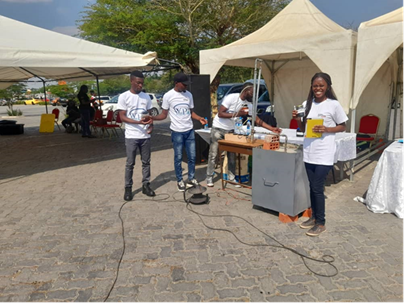Wast collection and Pyrolysis process is the process used to convert plastics and tires into its small chains called pyrolysis oils, from the pyrolysis oil that’s where we can obtain petrol and diesel after exposing it to a process of fractional distillation also reproducing of domestic plates and cups. After the extraction of the fuel from the plastics, what remains is char, which is 90% carbon and this can be used to make charcoal briquettes. If this can be produced in larger quantities, it will help in reducing deforestation as this can be used in place of charcoal from trees.
Charcoal briquettes from plastic waste

This strategy capitalizes on waste management and renewable energy, utilizing the skills of both skilled and unskilled youth from diverse communities to create valuable products and contribute to environmental sustainability.
West Pays Youth Movement
The initiative at hand aims to address a multifaceted challenge encompassing both environmental and economic dimensions. The primary concern revolves around the pressing issue of environmental degradation, particularly the adverse consequences stemming from plastic and tire pollution. The initiative seeks to introduce alternative solutions to mitigate these concerns and foster a sustainable future. The problem lies in the detrimental environmental effects triggered by rampant plastic and tire pollution. This initiative, by design, aspires to usher in a paradigm shift towards a cleaner and more ecologically balanced environment. It stands to significantly curtail the pervasive menace of plastic pollution, thereby precipitating a reduction in associated health hazards. A notable outcome of this endeavor would be the diminished incidence of respiratory afflictions attributed to the inhalation of plastic-related pollutants. Additionally, the initiative's holistic approach addresses the insidious problem of plastic-derived toxins infiltrating aquatic ecosystems. This, in turn, would ameliorate the contamination of fish and subsequent ingestion of harmful agents by humans. this initiative is rooted in the escalating challenges posed by surging plastic production, which has precipitated widespread environmental degradation. This initiative seeks to pivot this trajectory, presenting a comprehensive solution encompassing environmental rejuvenation, sustainable economic pathways, and societal well-being.
The proposed solution exhibits distinctive characteristics and innovative attributes aimed at addressing the prevailing challenges. It centres around a diverse cohort of young individuals hailing from various backgrounds and geographic locations. This assemblage includes both skilled and unskilled youths, fostering a dynamic and inclusive approach to tackling the identified issues. The initiative actively involves local communities in waste management efforts. This can include organizing clean-up drives, involving community members in waste segregation, and encouraging responsible disposal practices.
The initiative, tola tola west has demonstrated commendable progress in terms of its impacts and results. To date, the initiative has successfully engaged 45 youths in waste collection activities. This has translated into tangible positive outcomes, particularly in Kaunda Square Stage 2 area market, where a noticeable improvement in cleanliness has been observed. The initiative 88 has taken proactive steps towards environmental sustainability. One such measure involves the utilization of alternative fuel sources. A successful trial was conducted wherein a vehicle was operated using a different fuel type, showcasing the program's commitment to exploring eco-friendly options. Additionally, TOLA TOLA WASTE has also ventured into using charcoal briquettes as a substitute for traditional charcoal for cooking purposes. This transition highlights the program's dedication to adopting more environmentally conscious practices.
The initiative demonstrates an incremental level of experience. The established groundwork, community engagement, and ongoing operational efforts reflect a methodical approach to addressing waste management challenges, progressively advancing the initiative. The solution aligns with legal requirements, with no conflicts identified. Adherence to guidelines and standards guides the initiative's activities, ensuring compatibility with legal frameworks. Economically, the initiative is highly viable and accessible, with low initial investment requirements, primarily reliant on waste materials. When it comes to scaling up, it necessitates human resources for waste collection.
The initiative holds significant potential for scaling, with a multi-faceted approach that encompasses different dimensions of expansion. This involves a focus on in-depth growth through comprehensive training, mentorship programs, and fostering networks that support the development of robust communities of practice. While currently not in place, implementing such initiatives could provide individuals with the skills, knowledge, and support necessary to contribute effectively to waste management solutions. Scaling up involves engaging with policy, planning, and legislation to promote recognition and investment in the solution. Currently not established, aligning the initiative with policies that prioritize waste management and environmental preservation would further bolster its impact and reach. The initiative is vast, with prospects for deep growth through training and mentorship, scaling up through policy alignment, and scaling out through replication in different contexts. Establishing the necessary networks, policy support, and infrastructure will be instrumental in realizing this potential for broader impact.
Opportunities Available:
The initiative is well-positioned to seize various opportunities, including market expansion, collaborations, adaptation to new spaces, engagement in learning environments, participation in exhibitions, income generation, and youth employment. By capitalizing on these opportunities, the initiative can amplify its impact and contribute positively to its operational landscape
What should we do next?
The initiative's next steps involve securing financial support to enhance its operations and achieve its objectives. Through the utilization of modern materials, advanced computing systems, innovative waste collection strategies, and youth training, the initiative aims to expand its impact and operational scope. Your support in this endeavor would be instrumental in realizing these goals and fostering meaningful change.

